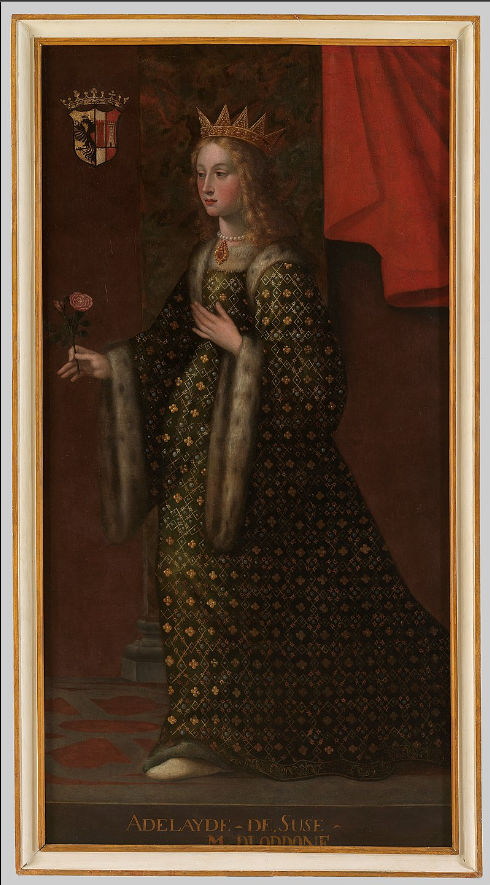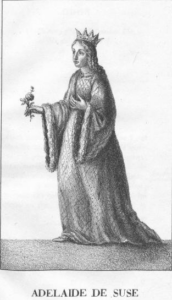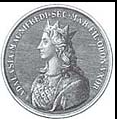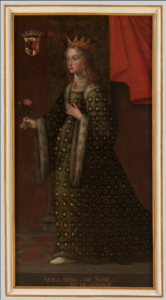
Adelaide De Suze
Date of Birth
1015
Place of Birth
Susa, Turin, Piedmont, Italy
Towns / Cities Moved Into
Susa, Turin, Piedmont, Italy
Geneva, Geneva,Switzerland
Canischio, Turin, Piedmont, Italy
Known Occupation
Marchioness of Turin
Countess of Savoy
Religion
-
Spouse
Death Information
Year of death
19 December 1091
Place of death
Canischio, Turin, Piedmont, Italy
Cause of death
-
Burial location
Parrocchia di Canischio at Canischio, Città Metropolitana di Torino, Piemonte, Italy
Obituary

Parents

Manfredo Ii Olderic D'Oriate

Berthe D'Ivrâee De Luni De Toscane
Marital Status
Siblings


Children








Narrative / Story
In the early 11th century, two influential figures, Eudes Odon de Savoie and Adelaide De Suze, embarked on individual paths that would eventually converge, profoundly shaping the House of Savoy and impacting the regions they governed. Eudes Odon, born between 1017 and 1020 in Geneva, Switzerland, was groomed from a young age for leadership, destined to become Conte di Savoia and Marchese of Susa. His upbringing in the bustling city of Geneva instilled in him a deep understanding of governance and politics, preparing him for his future roles.
Adelaide De Suze, born around 1014/1020 in Turin, Piedmont, Italy, navigated her early life through strategic marriages and inheritances. Her first marriage to Herman IV Duke of Swabia, arranged by Emperor Conrad II, was a move to secure her position as the margrave of Turin. After Herman’s death, she married Henry, Marquess of Montferrat, further expanding her influence and control over the region.
The paths of Adelaide and Eudes Odon intertwined around 1046 in a union that was more than a mere romantic alliance; it was a strategic merger that significantly altered the course of the House of Savoy. This marriage brought extensive possessions in northern Italy under their control, shifting the family’s focus towards Italy, particularly in modern Savoy and Piedmont.
Their journey from Geneva to Turin was not without its challenges. As newcomers in a foreign land, they encountered socio-economic issues and discrimination based on their foreign origins and race. Despite these challenges, they navigated through these hurdles to establish themselves and secure their position.
Eudes Odon’s responsibilities as Conte and Marchese involved intricate governance, taxation, and justice administration. Their court became a cultural and intellectual hub, reflecting their commitment to the arts and learning. Adelaide, a formidable Marchioness of Turin and Countess of Savoy, extended her influence to religious institutions. Her founding of the monastery of Santa Maria at Pinerolo in 1064 highlighted her dedication to religious patronage and philanthropy.
Their lives were set against a backdrop of significant historical events, including the Great Schism of 1054, which divided the Western and Eastern churches. Amidst this religious and political turmoil, Eudes Odon and Adelaide navigated their roles with resilience and determination.
The local and national history during this era was marked by shifts in power dynamics. Eudes Odon’s succession as ODDON Comte de Maurienne et de Chablais in 1051 was a pivotal moment for the House of Savoy, influencing the politics and culture of the regions they ruled.
The untimely death of Eudes Odon at 37 in Chambéry, Savoie, left Adelaide to continue their legacy. She supported her family and the imperial family through various political challenges, showcasing her strength and influence.
Eudes Odon de Savoie and Adelaide De Suze’s story is a testament to their resilience and nobility. They navigated socio-economic challenges, religious divisions, and political complexities, leaving an indelible mark on the House of Savoy during a time of great change and upheaval. Their legacy continues to resonate as a symbol of strength and determination in the face of adversity.
historical Events
Wedding, Marriage & Home
1st Marriage
- Holy Roman Emperor Conrad II arranged a marriage between Adelaide and his stepson, Herman IV Duke of Swabia, in January 1037, to serve as margrave of Turin after Ulric's death (father of Adelaide De Suze).
2nd Marriage
Adelaide remarried in order to secure her vast march. Probably in 1041, and certainly before 19 January 1042, Adelaide married Henry, Marquess of Montferrat.
3rd Marriage
On her third marriage, this time to Otto of Savoy (1046). With Otto she had three sons, Peter I, Amadeus II, and Otto. The couple also had two daughters, Bertha, who married Henry IV of Germany, and Adelaide, who married Rudolf of Rheinfelden
Notable Things Done in Lifetime
Adelaide's Diplomacy
In 1069 Henry IV tried to repudiate Adelaide's daughter, Bertha, which caused Adelaide's relationship with the imperial family to cool. However, through the intervention of Bertha, Henry received Adelaide's support when he came to Italy to submit to Pope Gregory VII and Matilda of Tuscany at Canossa. In return for allowing him to travel through her lands, Henry gave Bugey to Adelaide. Adelaide and her son Amadeus then accompanied Henry IV and Bertha to Canossa, where Adelaide acted as an oath-helper, alongside Matilda and Albert Azzo II, Margrave of Milan, among others. Bishop Benzo of Alba sent several letters to Adelaide between 1080 and 1082, encouraging her to support Henry IV in the Italian wars which formed part of the Investiture Controversy. Adelaide's dealings with Henry IV became closer after this. She offered to mediate between him and Matilda and Tuscany, and may even have joined him on campaign
Relevant events in their time period in their town
Donation
Adelaide made many donations to monasteries in the march of Turin. In 1064 she founded the monastery of Santa Maria at Pinerolo.


